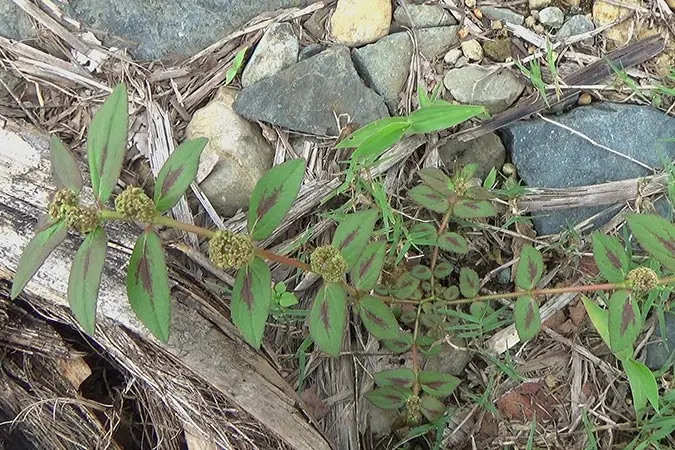Patikan kebo or asthma plant (Euphorbia hirta) is a species of plant in the Euphorbiaceae, an annual herb, prostrate or erect, growing to 60 cm, stems cylindrical, reddish green, hairy and producing abundant white latex, white or brown taproot.
E. hirta has leaves having short stalks, sitting in pairs and opposite on the stem. Strands are elliptical, margin serrated, up to 5 veins, hairy on both sides, completely green or have a dark red plot in the center.
The flowers are unisexual, grow in the axils of the leaves at each leaf node, have no petals and are generally on the stalk. The fruit is a capsule with 3 valves and produces seeds that are red and oval in shape with 4 sides.
Asthma plants grow in forests, open meadows, roadsides and agricultural land. Widely used in traditional herbal medicine in many cultures, especially for asthma, skin diseases, and hypertension. Consumed in the form of herbal teas as a traditional remedy for dengue fever and malaria.
Kingdom: Plantae
Phylum: Tracheophyta
Subphylum: Angiospermae
Class: Magnoliopsida
Order: Malpighiales
Family: Euphorbiaceae
Subfamily: Euphorbioideae
Tribe: Euphorbieae
Subtribe: Euphorbiinae
Genus: Euphorbia
Subgenus: Chamaesyce
Section: Anisophyllum
Species: Euphorbia hirta
E. hirta has leaves having short stalks, sitting in pairs and opposite on the stem. Strands are elliptical, margin serrated, up to 5 veins, hairy on both sides, completely green or have a dark red plot in the center.
The flowers are unisexual, grow in the axils of the leaves at each leaf node, have no petals and are generally on the stalk. The fruit is a capsule with 3 valves and produces seeds that are red and oval in shape with 4 sides.
Asthma plants grow in forests, open meadows, roadsides and agricultural land. Widely used in traditional herbal medicine in many cultures, especially for asthma, skin diseases, and hypertension. Consumed in the form of herbal teas as a traditional remedy for dengue fever and malaria.
Kingdom: Plantae
Phylum: Tracheophyta
Subphylum: Angiospermae
Class: Magnoliopsida
Order: Malpighiales
Family: Euphorbiaceae
Subfamily: Euphorbioideae
Tribe: Euphorbieae
Subtribe: Euphorbiinae
Genus: Euphorbia
Subgenus: Chamaesyce
Section: Anisophyllum
Species: Euphorbia hirta
